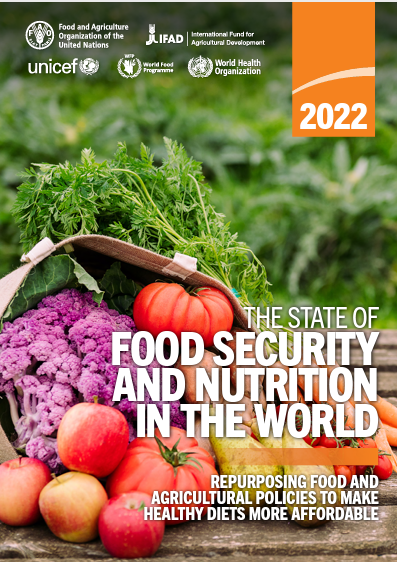by Marion Nestle
Jul
12
2022
The UN releases dismal report on world hunger
FAO and other UN agencies. released the 2022 edition of The State of Food Security and Nutrition in the World (SOFI).

Here’s the video that comes with it: A Tale of Empty Plates.
The report does not mince words:
- This year’s report should dispel any lingering doubts that the world is moving backwards in its efforts to end hunger, food insecurity and malnutrition in all its forms.
- The distance to reach many of the SDG 2 [Sustainable Development Goal #2, Zero Hunger] targets is growing wider each year.
- The intensification of the major drivers behind recent food insecurity and malnutrition trends (i.e. conflict, climate extremes and economic shocks) combined with the high cost of nutritious foods and growing inequalities will continue to challenge food security and nutrition.
As the press release puts it, “The numbers paint a grim picture:”
- As many as 828 million people were affected by hunger in 2021 – 46 million people more from a year earlier and 150 million more from 2019.
- …the proportion of people affected by hunger jumped in 2020 and continued to rise in 2021, to 9.8 percent of the world population. This compares with 8 percent in 2019 and 9.3 percent in 2020.
- Around 2.3 billion people in the world (29.3 percent) were moderately or severely food insecure in 2021 – 350 million more compared to before the outbreak of the COVID‑19 pandemic.
- The gender gap in food insecurity continued to rise in 2021 – 31.9 percent of women in the world were moderately or severely food insecure, compared to 27.6 percent of men.
- Almost 3.1 billion people could not afford a healthy diet in 2020, up 112 million from 2019.
- An estimated 45 million children under the age of five were suffering from wasting….149 million children under the age of five had stunted growth and development due to a chronic lack of essential nutrients in their diets, while 39 million were overweight.
The one bright note:
- Progress is being made on exclusive breastfeeding, with nearly 44 percent of infants under six months of age being exclusively breastfed worldwide in 2020. This is still short of the 50 percent target by 2030. Of great concern, two in three children are not fed the minimum diverse diet they need to grow and develop to their full potential.
But overall
- nearly 670 million people (8 percent of the world population) will still be facing hunger in 2030.
- This is a similar number to 2015, when the goal of ending hunger, food insecurity and malnutrition by the end of this decade was launched under the 2030 Agenda for Sustainable Development.
- In otherwords, there has been no progress since 2015.
If we want to fix this, we will have to:
- End the pandemic
- End wars
- End climate change
- End income and social inequalities
There’s our agenda. That’s all. Get busy.

